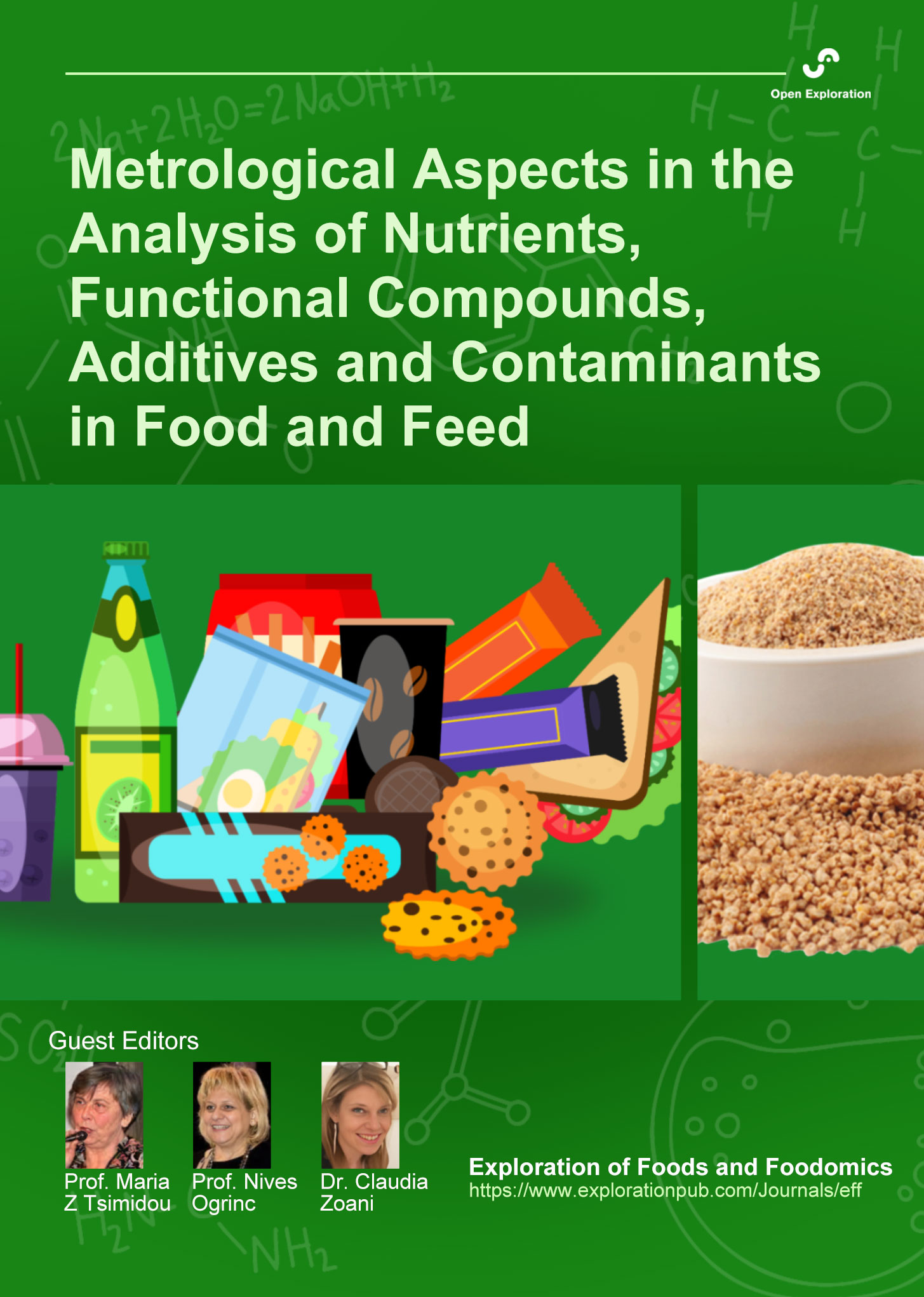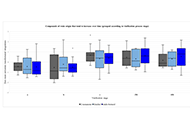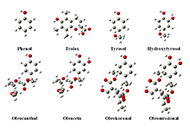-
 Special Issue Topic
Special Issue TopicMetrological Aspects in the Analysis of Nutrients, Functional Compounds, Additives and Contaminants in Food and Feed
Submission Deadline: November 01, 2025Guest Editors
Maria Z. Tsimidou E-Mail
Professor Emerita of Food Chemistry, Aristotle University of Thessaloniki, Thessaloniki, Greece
Research Keywords: nutrients; functional compounds; foo(ee)d additives; method validation; metabolomics
Nives Ogrinc E-Mail
Professor of Ecotechnology, Jožef Stefan International Postgraduate School and Jožef Stefan Institute, Ljubljana, Slovenia
Research Keywords: stable isotopes; trace and toxic element analysis and speciation; volatile organic compounds; metrology
Claudia Zoani E-Mail
Coordinator of METROFOOD-RI, Researcher ENEA, C.R. Casaccia, Rome - Italy
Research Keywords: elemental analysis; emerging contaminants; metrology; research infrastructures; reference materials
About the Special Issue
Dear Colleagues,
We accepted with pleasure the invitation made by Prof. Alejandro Cifuentes and Prof. Elena Ibáñez to be the guest editors of a Special Issue for the open access, bimonthly published and multidisciplinary journal Exploration of Foods and Foodomics that aims at publishing papers of the highest quality and significance in all areas of Foodomics.
We know and collaborate with each other for many years within (and beyond) the frame of METROFOOD-RI, the European Research Infrastructure that set as a priority the high – level metrology services in food and nutrition for the enhancement of food quality and safety. Our common code in scientific actions is to support the practical realisation of the “One Health” approach in foo(ee)d analysis in the whole agroecosystem and in the whole food chain. We fully acknowledge the complexity of foo(ee)d systems in terms of their physical, chemical, nutritional, biological composition and properties and, thus, all aspects in foo(ee)d analysis are welcome.
The thematic area proposed is related to the everyday concern of each food and feed analyst as to how confidence in the analytical data produced in accredited and non-accredited laboratories is secured. Metrology represents the essential basis to make data reliable, providing objectivity and impartiality, supporting harmonisation, and ensuring the comparability of measurement results including reference material production and characterization. Its application to foo(ee)d and nutrition represents an engine to promote research and innovation, infrastructures’ operation, technology advancements, cooperation in global trade, economy and strengthening citizen trust. The application of metrological concepts is essential also with reference to digitalisation and digital transformation when measurements are involved.
New methods, new instrumentation, new materials, new software demand a continuous updating of analytical protocols for an easier and trustful data production and communication. Non-targeted and targeted analytical protocols present different characteristics that have to be addressed from the metrological point of view. Automation, device development and application are ongoing challenging areas of analytical practice that has to also adopt metrological aspects. Data transferability and building of data banks point out to metrology as a prerequisite.
NO-APC (Article Process Charge) policy applies, so authors do not need to pay any fee during the whole process.
The deadline of manuscript submission (review articles, original research, short communication, viewpoints) is May 01, 2025.
Keywords: food and feed analysis; metrological traceability; analytical methods; sensors and portable devices; method validation; reference materials; nutraceutical and functional foods; emerging contaminants; nutrients; functional compounds; additives and contaminants
Call for Papers
Published Articles
 How can a European research infrastructure promote metrological aspects of food/feed and nutrition analysis?Open AccessCommentaryResearch infrastructures (RIs) are central to European Union (EU) policies for defragmentation of the research and innovation in all fields of science and technology providing resources, expertise, [...] Read more.Maria Z. Tsimidou ... Claudia ZoaniPublished: February 10, 2025 Explor Foods Foodomics. 2025;3:101071
How can a European research infrastructure promote metrological aspects of food/feed and nutrition analysis?Open AccessCommentaryResearch infrastructures (RIs) are central to European Union (EU) policies for defragmentation of the research and innovation in all fields of science and technology providing resources, expertise, [...] Read more.Maria Z. Tsimidou ... Claudia ZoaniPublished: February 10, 2025 Explor Foods Foodomics. 2025;3:101071
DOI: https://doi.org/10.37349/eff.2025.101071 From data to nutrition: the impact of computing infrastructure and artificial intelligenceOpen AccessPerspectiveThis article explores the significant impact that artificial intelligence (AI) could have on food safety and nutrition, with a specific focus on the use of machine learning and neural networks for d [...] Read more.Pierpaolo Di Bitonto ... Sabina TangaroPublished: December 03, 2024 Explor Foods Foodomics. 2024;2:810–829
From data to nutrition: the impact of computing infrastructure and artificial intelligenceOpen AccessPerspectiveThis article explores the significant impact that artificial intelligence (AI) could have on food safety and nutrition, with a specific focus on the use of machine learning and neural networks for d [...] Read more.Pierpaolo Di Bitonto ... Sabina TangaroPublished: December 03, 2024 Explor Foods Foodomics. 2024;2:810–829
DOI: https://doi.org/10.37349/eff.2024.00063 Detection of pharmaceuticals and their transformation products in seawaters using off-line solid phase extraction and liquid chromatography-high resolution mass spectrometryOpen AccessOriginal ArticleAim: Fast urbanization of free land, industrial progress, and improvement of human life quality, have led to increased consumption of different chemical substances recognized as emerging contaminants (ECs) that are chemicals posin [...] Read more.Aggeliki Kalogeropoulou ... Triantafyllos AlbanisPublished: November 29, 2024 Explor Foods Foodomics. 2024;2:767–787
Detection of pharmaceuticals and their transformation products in seawaters using off-line solid phase extraction and liquid chromatography-high resolution mass spectrometryOpen AccessOriginal ArticleAim: Fast urbanization of free land, industrial progress, and improvement of human life quality, have led to increased consumption of different chemical substances recognized as emerging contaminants (ECs) that are chemicals posin [...] Read more.Aggeliki Kalogeropoulou ... Triantafyllos AlbanisPublished: November 29, 2024 Explor Foods Foodomics. 2024;2:767–787
DOI: https://doi.org/10.37349/eff.2024.00061 Exploring the potential of triticale lines for bioethanol productionOpen AccessOriginal ArticleAim: Triticale is a well adaptable crop, tolerant of disease and abiotic stresses, and able to grow with good yields even in poor soil, thus representing a good choice to develop a new industrial [...] Read more.Arianna Latini ... Patrizia GaleffiPublished: October 21, 2024 Explor Foods Foodomics. 2024;2:613–625
Exploring the potential of triticale lines for bioethanol productionOpen AccessOriginal ArticleAim: Triticale is a well adaptable crop, tolerant of disease and abiotic stresses, and able to grow with good yields even in poor soil, thus representing a good choice to develop a new industrial [...] Read more.Arianna Latini ... Patrizia GaleffiPublished: October 21, 2024 Explor Foods Foodomics. 2024;2:613–625
DOI: https://doi.org/10.37349/eff.2024.00054 In-tube extraction dynamic headspace coupled to gas chromatography-mass spectrometry for the sensitive analysis of volatile compounds in aqueous samplesOpen AccessOriginal ArticleAim: Volatile organic compounds (VOCs) are often human-made contaminants used and generated in the manufacturing of numerous products, presenting notable environmental and health hazards. Therefo [...] Read more.Eleni Zymvrakaki ... Urania Menkissoglu-SpiroudiPublished: October 12, 2024 Explor Foods Foodomics. 2024;2:599–612
In-tube extraction dynamic headspace coupled to gas chromatography-mass spectrometry for the sensitive analysis of volatile compounds in aqueous samplesOpen AccessOriginal ArticleAim: Volatile organic compounds (VOCs) are often human-made contaminants used and generated in the manufacturing of numerous products, presenting notable environmental and health hazards. Therefo [...] Read more.Eleni Zymvrakaki ... Urania Menkissoglu-SpiroudiPublished: October 12, 2024 Explor Foods Foodomics. 2024;2:599–612
DOI: https://doi.org/10.37349/eff.2024.00053 Analytical aspects of metagenomic and volatilomic approaches that advance table olive integrity researchOpen AccessReviewTable olives are one of the most widespread fermented foods in the Mediterranean area, presenting an exponential increase in global consumption in the latest years. As a fermented product, its micro [...] Read more.Despoina Langari, Fani Th. MantzouridouPublished: September 26, 2024 Explor Foods Foodomics. 2024;2:570–598
Analytical aspects of metagenomic and volatilomic approaches that advance table olive integrity researchOpen AccessReviewTable olives are one of the most widespread fermented foods in the Mediterranean area, presenting an exponential increase in global consumption in the latest years. As a fermented product, its micro [...] Read more.Despoina Langari, Fani Th. MantzouridouPublished: September 26, 2024 Explor Foods Foodomics. 2024;2:570–598
DOI: https://doi.org/10.37349/eff.2024.00052 Inorganic contaminants and micronutrients in foods consumed by the vegetarian Portuguese populationOpen AccessOriginal ArticleAim: The present study aimed to determine the profile of micronutrients and inorganic contaminants in the plant-based and dairy food products most consumed by the Portuguese population. Meth [...] Read more.Sandra Gueifão ... Inês CoelhoPublished: September 24, 2024 Explor Foods Foodomics. 2024;2:555–569
Inorganic contaminants and micronutrients in foods consumed by the vegetarian Portuguese populationOpen AccessOriginal ArticleAim: The present study aimed to determine the profile of micronutrients and inorganic contaminants in the plant-based and dairy food products most consumed by the Portuguese population. Meth [...] Read more.Sandra Gueifão ... Inês CoelhoPublished: September 24, 2024 Explor Foods Foodomics. 2024;2:555–569
DOI: https://doi.org/10.37349/eff.2024.00051 Exploring the potential of laser photoacoustic spectroscopy (LPAS) for predicting amylose content in rice flourOpen AccessOriginal ArticleAim: Rice, one of the most widely consumed staple foods globally, relies on amylose content for its quality, impacting cooking, digestibility, and health properties. Conventional amylose determin [...] Read more.Florinda Artuso ... Fabio PollastronePublished: September 10, 2024 Explor Foods Foodomics. 2024;2:542–554
Exploring the potential of laser photoacoustic spectroscopy (LPAS) for predicting amylose content in rice flourOpen AccessOriginal ArticleAim: Rice, one of the most widely consumed staple foods globally, relies on amylose content for its quality, impacting cooking, digestibility, and health properties. Conventional amylose determin [...] Read more.Florinda Artuso ... Fabio PollastronePublished: September 10, 2024 Explor Foods Foodomics. 2024;2:542–554
DOI: https://doi.org/10.37349/eff.2024.00050 Exploring the effect of Pinus halepensis resin quality on the vinification of Retsina by untargeted profile analysisOpen AccessOriginal ArticleAim: Three factors that affect the chemical composition and perceptible aroma of Retsina—a distinguished Greek wine, crafted by infusing resin harvested from the Aleppo pine (Pinus halepensis M [...] Read more.Alexandros Nakas ... Andreana N. AssimopoulouPublished: August 29, 2024 Explor Foods Foodomics. 2024;2:497–524
Exploring the effect of Pinus halepensis resin quality on the vinification of Retsina by untargeted profile analysisOpen AccessOriginal ArticleAim: Three factors that affect the chemical composition and perceptible aroma of Retsina—a distinguished Greek wine, crafted by infusing resin harvested from the Aleppo pine (Pinus halepensis M [...] Read more.Alexandros Nakas ... Andreana N. AssimopoulouPublished: August 29, 2024 Explor Foods Foodomics. 2024;2:497–524
DOI: https://doi.org/10.37349/eff.2024.00048 Assessing the presence and health risks of potentially toxic metals in food: a comprehensive overviewOpen AccessReviewFood products can contain various substances, including essential nutrients, as well as non-nutritive elements and potentially toxic metals. Metal contaminants have the potential to accumulate withi [...] Read more.Gabriel Mustatea, Elena L. UngureanuPublished: August 19, 2024 Explor Foods Foodomics. 2024;2:471–496
Assessing the presence and health risks of potentially toxic metals in food: a comprehensive overviewOpen AccessReviewFood products can contain various substances, including essential nutrients, as well as non-nutritive elements and potentially toxic metals. Metal contaminants have the potential to accumulate withi [...] Read more.Gabriel Mustatea, Elena L. UngureanuPublished: August 19, 2024 Explor Foods Foodomics. 2024;2:471–496
DOI: https://doi.org/10.37349/eff.2024.00047 Quality, safety and authenticity of insect protein-based food and feed: insights from the INPROFF ProjectOpen AccessReviewThis paper reviews the nutritional quality and safety of edible farmed insects from the point of view of the Czech-Slovenian bilateral project: Quality, Safety and Authenticity of Insect Protein-based Food and Feed (INPROFF). Inse [...] Read more.David Heath ... Nives OgrincPublished: July 24, 2024 Explor Foods Foodomics. 2024;2:339–362
Quality, safety and authenticity of insect protein-based food and feed: insights from the INPROFF ProjectOpen AccessReviewThis paper reviews the nutritional quality and safety of edible farmed insects from the point of view of the Czech-Slovenian bilateral project: Quality, Safety and Authenticity of Insect Protein-based Food and Feed (INPROFF). Inse [...] Read more.David Heath ... Nives OgrincPublished: July 24, 2024 Explor Foods Foodomics. 2024;2:339–362
DOI: https://doi.org/10.37349/eff.2024.00041 Metrological aspects of a gas-phase DFT/B3LYP quantum-chemical approach to prioritize radical scavenging activity among a group of olive oil phenolsOpen AccessOriginal ArticleAim: A protocol relying on quantum chemical calculations to assist prioritization of phenolic compounds as antioxidants in terms of hydrogen atom donation efficiency is presented. The use of reference compounds, an important metro [...] Read more.Nikolaos Nenadis, Maria Z. TsimidouPublished: July 18, 2024 Explor Foods Foodomics. 2024;2:326–338
Metrological aspects of a gas-phase DFT/B3LYP quantum-chemical approach to prioritize radical scavenging activity among a group of olive oil phenolsOpen AccessOriginal ArticleAim: A protocol relying on quantum chemical calculations to assist prioritization of phenolic compounds as antioxidants in terms of hydrogen atom donation efficiency is presented. The use of reference compounds, an important metro [...] Read more.Nikolaos Nenadis, Maria Z. TsimidouPublished: July 18, 2024 Explor Foods Foodomics. 2024;2:326–338
DOI: https://doi.org/10.37349/eff.2024.00040 Building a database for the quality characteristics of the Protected Designation of Origin saffron Krokos Kozanis, considering international trade requirementsOpen AccessOriginal ArticleAim: Saffron, a precious spice deriving from the emblematic Crocus sativus L. cultivation, is a traditional product with high socio-economic and cultural value in Greece, especially in the region [...] Read more.Stella A. Ordoudi, Maria Z. TsimidouPublished: June 07, 2024 Explor Foods Foodomics. 2024;2:236–251
Building a database for the quality characteristics of the Protected Designation of Origin saffron Krokos Kozanis, considering international trade requirementsOpen AccessOriginal ArticleAim: Saffron, a precious spice deriving from the emblematic Crocus sativus L. cultivation, is a traditional product with high socio-economic and cultural value in Greece, especially in the region [...] Read more.Stella A. Ordoudi, Maria Z. TsimidouPublished: June 07, 2024 Explor Foods Foodomics. 2024;2:236–251
DOI: https://doi.org/10.37349/eff.2024.00036 -
-
Ongoing Special Issues
-
Completed Special Issues